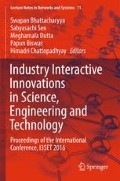Abstract
With the emergence of multidrug resistant mycobacterium tuberculosis, it is an immediate necessity to design new potent drugs. One step toward it is to understand the mechanism of inhibition of the enzyme InhA (trans-2-enoyl-ACP-reductase), which has an important function in the building of micobacterial cell wall. An attempt through molecular modeling and simulation methods is presented here to explain binding affinities of different derivatives of drugs and also the role of some important amino acid residues in the active site of the InhA.
Access this chapter
Tax calculation will be finalised at checkout
Purchases are for personal use only
References
Rozwarski, D.A.: Crystal structure of the Micobacterium tuberculosis enoyl-ACP reductase, InhA in complex with NAD+ and a C16 fatty acyl substrate. J. Biol. Chem. 274, 15582–155589 (1999)
Luckner, S.R.: X ray crystal structure of a slow, tight binding inhibitor of InhA from M. Tb. J. Biol. Chem. 285, 14330 (2010)
He, X., et al.: Pyrrolidine carboxamides as a novel class of inhibitors of InhA from M.Tb. J. Med. Chem. 49(21), 6308–6323 (2006)
Punkvang, A., et al.: Investigating the structural basis of arylamides to improve potency against M. Tuberculosis strain through molecular dynamics simulation. Eur. J. Med. Chem. 45, 93–5585 (2010)
Schroeder et al.: Molecular dynamics simulation studies of the wild type I 21 V and I 16T mutants of isoniazid resistant M. Tb InhA in complex with NADH, Towards understanding of NADH–InhA different affinities. Biophys. J. 89, 876–884 (2005)
He, X., et al.: Inhibition of the MTb enoyl acyl carrier protein reductase InhA by arylamides. Bioorg. Med. Chem. 15(21), 6649–6658 (2007)
Subba Rao, G., Vijayakrishnan, R., Kumar, M.: Structure based design of a novel class of potent inhibitors of InhA, the enoyl acyl carrier protein reductase from micobacterium tuberculosis: a computer modeling approach. Chem. Biol. Drug Des. 72, 444–449 (2008)
Kumar, M., Vijayakrishnan, R., Subba Rao, G.: In silico structure based design of a novel class of potent and selective small peptide inhibitor of M.Tb. Dihydrate reductase, a potential target for anti T.B. drug discovery. Mol. Divers. 14(3), 594–604 (2010)
Muralidharan, J., Suguna, K., Surolia, N.: Exploring the interaction energies for the binding of hydroxydiphenyl ethers to enoyl acyl carrier protein reductases. J. Biomol. Struct. Dyn. 20, 589–94 (2003)
Kini, S.G., Bhat, A.K.: Synthesis, antitubercular activity and docking study of novel cyclic azole substituted diphenyl ether derivatives. Eur. J. Med. Chem. 44, 492–500 (2009)
Kouassi, A.F., et al.: Computer-aided design of orally bioavailable pyrrolidine carboxamide inhibitors of enoyl-acyl carrier protein reductase of Mycobacterium tuberculosis with favorable pharmacokinetic profiles. Int J. Mol. Sci. 16(12), 29744–29771 (2015)
Acknowledgements
The author is thankful to the University Grant Commission, Government of India for providing necessary facilities.
Author information
Authors and Affiliations
Corresponding author
Editor information
Editors and Affiliations
Rights and permissions
Copyright information
© 2018 Springer Nature Singapore Pte Ltd.
About this paper
Cite this paper
Sarkar, I., Goswami, S. (2018). Computational Methodologies Followed in Structure Based In-Silico Drug Design: An Example. In: Bhattacharyya, S., Sen, S., Dutta, M., Biswas, P., Chattopadhyay, H. (eds) Industry Interactive Innovations in Science, Engineering and Technology . Lecture Notes in Networks and Systems, vol 11. Springer, Singapore. https://doi.org/10.1007/978-981-10-3953-9_55
Download citation
DOI: https://doi.org/10.1007/978-981-10-3953-9_55
Published:
Publisher Name: Springer, Singapore
Print ISBN: 978-981-10-3952-2
Online ISBN: 978-981-10-3953-9
eBook Packages: EngineeringEngineering (R0)

